Andyson Platinum R1200 Power Supply Review
Why you can trust Tom's Hardware
A Look Inside And Component Analysis
Our main tools for the disassembly of each PSU we examine are a Thermaltronics soldering and rework station, along with a Hakko 808 de-soldering gun.
Parts Description
| Primary Side | |
|---|---|
| Transient Filter | 4x Y caps, 2x X caps, 2x CM chokes, 1x MOV |
| Inrush Protection | NTC Thermistor |
| Bridge Rectifier(s) | 2x Vishay BU1506 |
| APFC MOSFETs | 2x Infineon IPW50R140CP MOSFETs |
| APFC Boost Diode | 1x CREE C3D10060G |
| Hold-up Cap(s) | 3x Nippon Chemi-Con (400V, 470uF each; 1410uF combined, 105 °C, KMR) |
| Main Switchers | 4x STFI26NM60N |
| APFC Controller | Champion CM6502 |
| Switching Controller | Champion CM6901 |
| Topology | Primary side: Full-Bridge and LLC Resonant Converter Secondary side: Synchronous Rectification & DC-DC converters |
| Secondary Side | |
| +12V MOSFETs | 8x Infineon IPP015N04N G |
| 5V and 3.3V | DC-DC Converters: 2x CSD86350Q5D Power Blocks 2x APW7073 PWM Controllers |
| Filtering Capacitors | Electrolytics: Teapo, Nippon Chemi-Con, 105 °C Polymers: Teapo |
| Supervisor IC | SITI PS223 |
| Fan Model | ADDA ADN512DB-A91 (135mm, 12V, 0.15A, 1600 RPM, 39.5 dB(A), 70,000-hour MTBF) |
| 5VSB Circuit | |
| Rectifying Diode | 1x PFC PFR20L60CT |
| Standby PWM Controller | STR-A6069H |

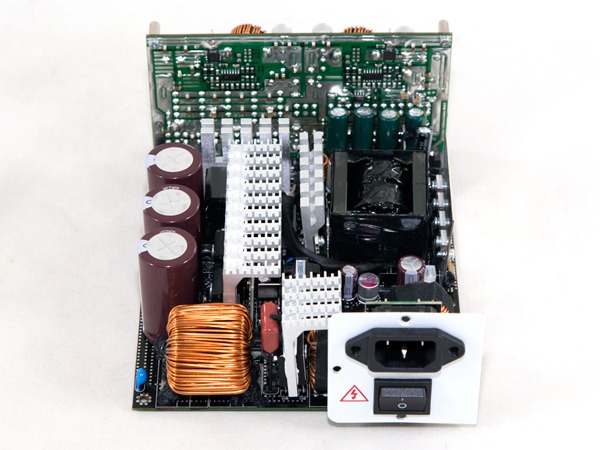



Andyson uses cutting-edge technology in this platform, which, in addition to a uniquely designed EMI filter, includes a full-bridge topology along with an LLC resonant converter. The only thing missing is a bridgeless PFC design, though for Platinum-class efficiency it isn't necessary. On the secondary side, a synchronous design is used, meaning the +12V rail is regulated only by active components (metal–oxide–semiconductor field-effect transistors, or MOSFETs) and not passive (Schottky Barrier Diodes, SBRs). In general, this platform is well-made and doesn't resemble Andyson's previous efforts. The engineers who built it should be proud of their work.





The transient/EMI filter is soldered directly to the main PCB; power cables aren't needed and the board looks way cleaner without them. The vertical daughterboard that houses the first part of the EMI filter has two Y capacitors on it. The rest of this filter's components are on the mainboard — two pairs of X and Y caps, along with two CM chokes and a MOV (metal-oxide varistor) that suppress spikes coming from the power grid.



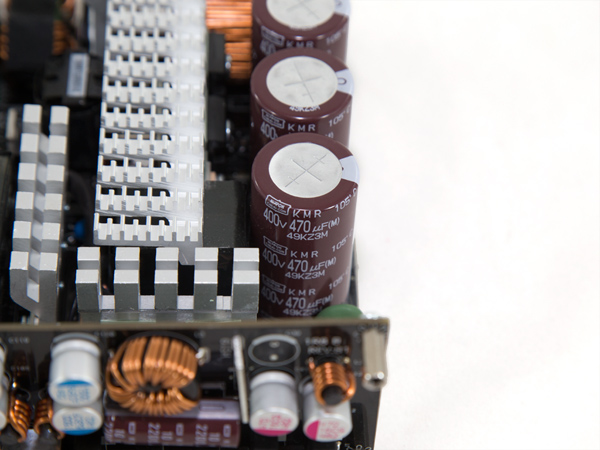



Two Vishay BU1506 bridge rectifiers are bolted to a dedicated heat sink. Combined, they can handle up to 30A of current, so they easily meet the needs of this PSU.
In the APFC converter, two Infineon IPW50R140CP MOSFETs are used, along with a single C3D10060G boost diode. The bulk caps are provided by Nippon Chemi-Con (400V, 470uF each, 105 °C, KMR series), and their combined capacity reaches 1410uF — a very large amount, even for a 1.2 kW PSU. There is one empty spot on the PSU's mainboard for an additional bulk capacitor, probably for a higher-wattage version of this same platform.
To restrict inrush current as much as possible, Andyson uses two NTC thermistors. However, we still got pretty high inrush current readings.
Four STFI26NM60N MOSFETs are used at the main switchers, arranged into a full-bridge topology. An LLC resonant converter also provides a significant efficiency boost by allowing for an almost lossless switching of the aforementioned MOSFETs.
Get Tom's Hardware's best news and in-depth reviews, straight to your inbox.
The APFC controller, a Champion CM6502 IC, is installed on a small, vertical daughterboard. The resonant controller, a CM6901 IC, is installed onto the solder side of the mainboard; it's also provided by Champion. Both of the above ICs are quite popular in Platinum-class PSUs.


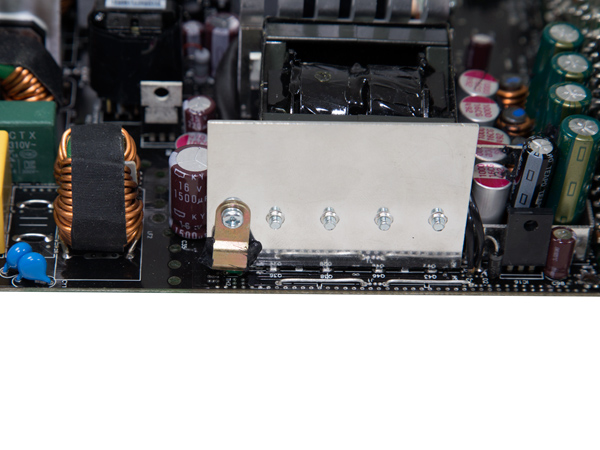

On the secondary side, eight Infineon IPP015N04N G MOSFETs are installed on two relatively small heat sinks. Obviously, due to their high efficiency, thicker heat sinks with fins weren't necessary.


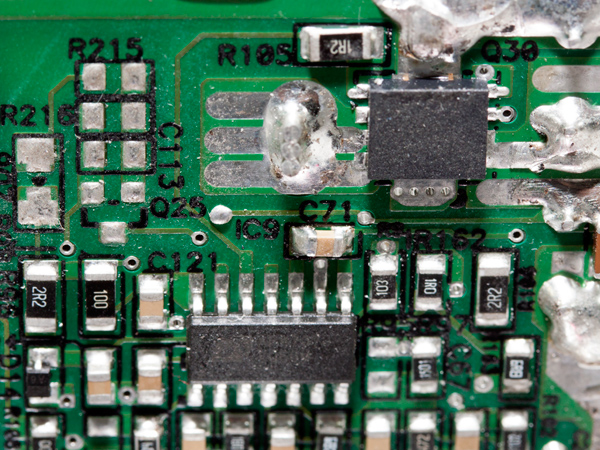
Both DC-DC converters that generate the minor rails are installed directly onto the modular PCB. This setup restricts energy losses, as their outputs are close to the modular sockets. In other designs where the same converters are located farther from the modular board, their power output has to be transferred somehow up to the modular sockets. So, inevitably, there are power losses on transfer cables or PCB traces, affecting the overall efficiency. SeaSonic and Enermax were among the first to utilize this technique.



On the front of the modular PCB are two large electrolytic Chemi-Con caps (KY series), several smaller polymer caps provided by the same vendor and nine polymer capacitors, provided by Teapo. We also find another polymer cap produced by Kingcom.
On the secondary side, there is a mix of Taiwanese (Teapo) and Japanese (Chemi-Con) electrolytic capacitors, all rated at 105 degrees Celsius (221 degrees Fahrenheit). In such a high-end platform, we would highly prefer if all capacitors were provided by a Japanese maker, but Andyson apparently has a different opinion. Finally, there are some polymer caps made by Teapo.
Housekeeping duties are handled by a SITI PS223 IC, which is among the few that support over-temperature protection (OTP) out of the box. Since this IC supports OTP, we really wonder why Andyson doesn't exploit this capability. The same IC also features over-current protection (OCP) for up to two +12V rails. This power supply only has one +12V rail though, so it doesn't need OCP; in single +12V rail PSUs, OPP takes over OCP's functionality.
The standby PWM controller is an STR-A6069H; it cooperates with a PFC PFR20L60CT SBR that rectifies the 5VSB rail.







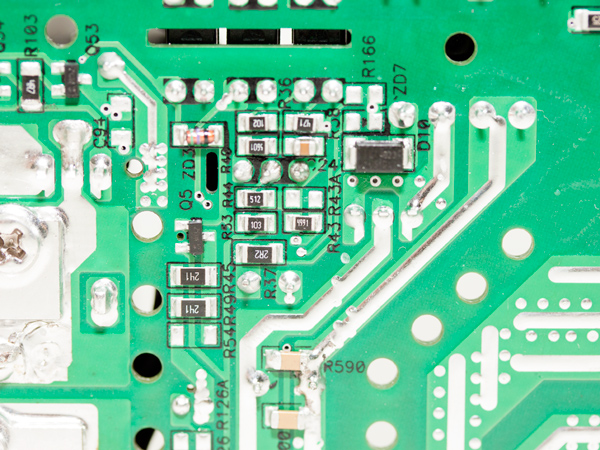



Overall, the soldering quality is good. It might not be up to Delta's or Flextronic's standards, but we approve nonetheless. This shows that Andyson put a lot of effort not only into the design of this platform, but also in manufacturing it properly.
The cooling fan is provided by ADDA, and its model number is ADN512DB-A91 (135mm, 12V, 0.15A, 2000 RPM, 153.47 CFM, 39.5 dB(A), 70,000-hour MTBF). It uses ball bearings, so it will last for quite a long time — much longer than a sleeve-bearing fan.
Current page: A Look Inside And Component Analysis
Prev Page Packaging, Contents, Exterior And Cabling Next Page Load Regulation, Hold-Up Time And Inrush Current
Aris Mpitziopoulos is a contributing editor at Tom's Hardware, covering PSUs.
-
blackmagnum Thank you for the read. Did you know that the power feeding this PSU can instead be fed into 3 normal sized machines? The power of choice is yours to make, but electricity will not be infinite.Reply -
iam2thecrowe Teapo capacitors are a hit and miss. I'd say if your running it 24/7 as a coin mining machine with high load it would not last 10 years. For normal use with a few hours gaming per day it might be ok, but 10 years is a long shot for even the best capacitors not to have some degradation.Reply -
daglesj Can we have some reviews of really high quality 300-600W PSUs? You know the ones that 90% of us here would actually use/need.Reply -
vrumor ReplyThank you for the read. Did you know that the power feeding this PSU can instead be fed into 3 normal sized machines? The power of choice is yours to make, but electricity will not be infinite.
Did you know that anyone who cares about this PSU, isnt going to be thinking about the 3 400w HTPCs that it could run. Keep your politics out of a PSU review lol. -
rolli59 Always nice to see reviews of the high end stuff but really the 300-850watt range will cover the needs of 99% of readers of the side.Reply
Now lets see if Andyson can follow up and start putting out decent lower power units. -
damric Andyson, the notorious RAIDMAX OEM. Not sure any sane person would pick you for a high end PSU, but thanks for trying.Reply
-
iam2thecrowe ReplyCan we have some reviews of really high quality 300-600W PSUs? You know the ones that 90% of us here would actually use/need.
i disagree, can we get a roundup of complete rubbish generic psu's like low end radimax and the like and watch them burn! i think it needs to be done to show people what not to buy. -
damric Reply15588307 said:15588123 said:Andyson, the notorious RAIDMAX OEM. Not sure any sane person would pick you for a high end PSU, but thanks for trying.
is it andyson's fault that raidmax wants them to supply cheap PSU?
Yes, absolutely. Same with other OEMs like Channel Well that know how to make good PSUs but instead churn out cost-cutting junk because that's the best contracts that they can win. I am not forgiving when it comes to PSUs.


